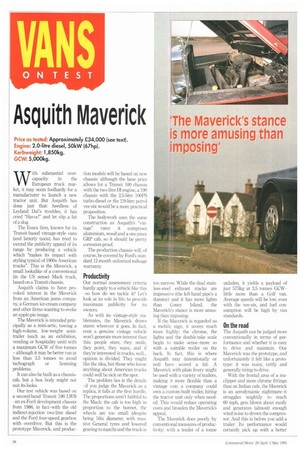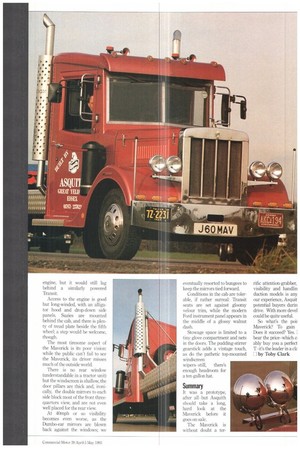Asquith Maverick
Page 60

Page 61

If you've noticed an error in this article please click here to report it so we can fix it.
Price as tested: Approximately £34,000 (see text). Engine: 2.0-litre diesel, 50kW (67hp). Kerbweight: 1,850kg.
GOV: 5,000kg.
With substantial overcapacity in the European truck market, it may seem foolhardy for a manufacturer to launch a new tractor unit. But Asquith has done just that heedless of Leyland Oaf's troubles, it has cried "Havoc!" and let slip a bit of a dog.
The Essex firm, known for its Transit-based vintage-style vans (and latterly taxis), has tried to extend the publicity appeal of its range by producing a vehicle which "makes its impact with styling typical of 1960s American trucks". This is the Maverick, a small kx)Icalike of a conventional (in the US sense) Mack truck, based on a Transit chassis.
Asquith claims to have provoked interest in the Maverick from an American jeans company, a German ice-cream company and other firms wanting to evoke an apple-pie image.
The Maverick is intended principally as a mini-artic, towing a high-volume, low-weight semitrailer (such as an exhibition, vending or hospitality unit) with a maximum GCW of five tonnes although it may be better run at less than 3.5 tonnes to avoid tachograph or licensing problems.
It can also be built as a chassiscab, but a box body might not suit its looks.
Our test vehicle was based on a second-hand Transit 190 LIAM an ex-Ford development chassis from 1986, in fact-with the old indirect-injection two-litre diesel and the Ford four-speed gearbox with overdrive. But this is the prototype Maverick, and pmduc
lion models will be based on new chassis: although the base price allows for a Transit 100 chassis with the two-litre DI engine, a 190 chassis with the 2.5-litre 100PS turbo-diesel or the 2.9-litre petrol vee-six would be a more practical proposition.
The bodywork uses the same construction as Asquith's "vintage" vans: it comprises aluminium, wood and a one-piece GRP cab, so it should be pretty corrosion-proof.
The production chassis will, of course, be covered by Ford's standard 12-month unlimited mileage warranty
Productivity
Our normal as.se.ssment criteria hardly apply to a vehicle like this -so how do we tackle it? Let's look at its role in life: to provide maximum publicity for its owners.
As with its vintage-style stablemates, the Maverick draws stares wherever it goes. In fact, even a genuine vintage vehicle won't generate more interest than this: people stare, they smile, they point, they wave, and if they're interested in trucks, well... opinion is divided. They might like the idea, but those who know anything about American trucks could well be sick on the spot.
The problem lies in the details -if you judge the Maverick as a replica, it falls at the first hurdle. The proportions aren't faithful to the Mack: the cab is too high in proportion to the bonnet, the wheels are too small (despite being 16in diameter, with massive General tyres and lowered gearing to match) and the track is too narrow While the dual stainless-steel exhaust stacks are impressive (the left-hand pipe's a dummy) and it has more lights than Coney Island, the Maverick's stance is more amusing than imposing.
If the Maverick is regarded as a mobile sign, it scores much more highly: the chrome, the lights and the double-take scale begin to make sense-more so with a suitable trailer on the back. In fact, this is where Asquith may (intentionally or not) have scored a hit. A Maverick with plain livery might be used with a variety of trailers, making it more flexible than a vintage van: a company could own a custom-built trailer, hiring the tractor unit only when needed. This would reduce operating costs and broaden the Maverick's appeal.
The Maverick does poorly by conventional measures of productivity: with a trailer of a tonne unladen, it yields a payload of just 575kg at 3.5 tonnes GCWlittle more than a Golf van. Average speeds will be low, even with the vee-six, and fuel consumption will be high by ran standards.
On the road
The Asquith can be judged more conventionally in terms of performance and whether it is easy to drive and maintain. Our Maverick was the prototype, and unfortunately it felt like a prototype: it was noisy, rattly and generally tiring to drive.
With the frontal area of a teaclipper and more chrome fittings than an Italian cafe, the Maverick is an aerodynamic nightmare-it struggles mightily to reach 60 mph, gets blown about easily and generates (almost) enough wind noise to drown the compressor. And this is before you add a trailer. Its performance would certainly pick up with a better engine, but it would still lag behind a similarly powered Transit.
Access to the engine is good but long-winded, with an alligator hood and drop-down side panels. Suzies are mounted behind the cab, and there is plenty of tread plate beside the fifth wheel; a step would be welcome, though.
The most tiresome aspect of the Maverick is its poor vision: while the public can't fail to see the Maverick, its driver misses much of the outside world.
There is no rear window (understandable in a tractor unit) but the windscreen is shallow, the door pillars are thick and, ironically, the double mirrors to each side block most of the front threequarters view, and are not even well placed for the rear view.
At 40mph or so visibility becomes even worse, as the Dumbo-ear mirrors are blown back against the windows; we eventually resorted to bungees to keep the mirrors tied forward.
Conditions in the cab are tolerable, if rather surreal: Transit seats are set against gloomy velour trim, while the modern Ford instrument panel appears in the middle of a glossy walnut dash.
Stowage space is limited to a tiny glove compartment and nets in the doors. The pudding-stirrer gearstick adds a vintage touch, as do the pathetic top-mounted windscreen wipers-still, there's enough headroom for a ten-gallon hat.
SUMMarY It was a prototype, after allbut Asquith should take a long, hard look at the Maverick before it goes on sale.
The Maverick is without doubt a ter rifle attention-grabber, visibility and handlin duction models is any our experience, Asquit potential buyers durin drive. With more devel could be quite useful.
So what's the poi: Maverick? To gain Does it succeed? Yes. I bear the price—which o ably buy you a perfect T—it's the leader in a clz Fl by Toby Clark




















































































































